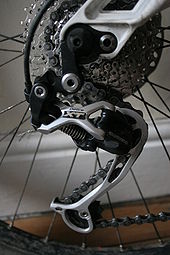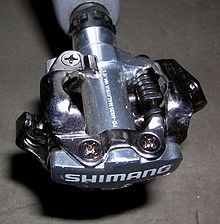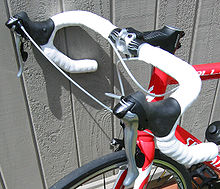- Shimano
-
Shimano, Inc. 
Type Public Industry cycling components, fishing tackle, snowboarding equipment Founded February, 1921 Headquarters Sakai, Osaka, Japan Key people Yozo Shimano (President)
Yoshizo Shimano (Chairman)Products Bicycle and Related Components Revenue undisclosed Employees 975 (unconsolidated)
7003 (consolidated)Website www.shimano.com Shimano, Inc. (TYO: 7309) is a Japanese multinational manufacturer of cycling components, fishing tackle, and rowing equipment.
In 2005, the company had net sales of US $1.4 billion. Bicycle components provided 75% of its sales income. Fishing tackle produced 23% of the company's sales income, while other products—including snowboarding equipment and other forged parts—produced about 2% of its sales income. Shimano produced golf supplies until 2005 and snowboarding equipment until 2008, when they abandoned the enterprises as unprofitable.
Headquartered in Sakai, Japan, the company has 32 consolidated subsidiaries and 11 unconsolidated subsidiaries. Its primary manufacturing plants are in Kunshan, China; Malaysia; and Singapore, while its sales are in Europe (41% of total sales) and North America (17%).
Shimano is publicly traded and has 102.8 million shares of common stock outstanding.[1]
Contents
Cycling
Shimano product sales constitute 50% of the global bicycle component market. Its products include drivetrain, brake, wheel and pedal components for road, mountain, and hybrid bikes.
The components include: crankset comprising cranks and chainrings; bottom bracket; chain; rear chain sprockets or cassette; front and rear wheel hubs; gear shift levers; brakes; brake levers; cables; front and rear gear mechanisms or dérailleurs. Shimano Total Integration (STI) is Shimano's integrated shifter and brake lever combination for racing bicycles.
The Italian firm Campagnolo as well as US based SRAM are Shimano's primary competitors in the cycling marketplace.
When the 1970s United States bike boom exceeded the capacity of the European bicycle component manufacturers, Japanese manufacturers SunTour and Shimano rapidly stepped in to fill the void. While both companies provided products for all price-ranges of the market, SunTour also focused on refinement of existing systems and designs for higher end products, while Shimano initially paid more attention to rethinking the basic systems and bringing out innovations such as Positron shifting (a precursor to index shifting) and front freewheel systems at the low end of the market.
In the 1980s, with Shimano pushing technological innovation and lower prices, the more traditional European component manufacturers lost significant market presence. During this period, in contrast to the near-universal marketing technique of introducing innovations on the expensive side of the marketplace and relying on consumer demand to emulate early adopters along with economy of scale to bring them into the mass market, Shimano and SunTour (to a lesser extent) introduced new technologies at the lowest end of the bicycle market, using lower cost and often heavier and less durable materials and techniques, only moving them further upmarket if they established themselves in the lower market segments.
In the 1980-1983 period, Shimano introduced three groupsets with "AX" technology: Dura-Ace & 600 (high-end), and Adamas in the low-end. Features of these components include aerodynamic styling, centre-pull brakes, brake levers with concealed cables, and ergonomic pedals.
By 1985 Shimano introduced innovation only at the highest quality level (Dura-Ace for road bikes and Deore XT for mountain bikes), then trickled the technology down to lower product levels as it became proven and accepted. Innovations include index shifting (known as SIS, Shimano Index System introduced in 1984),[2] freehubs, dual-pivot brakes, 8-9-10 speed drivetrains, and the integration of shifters and brake levers. Also, these components could only work properly when used with other Shimano components, e.g. its gear rear dérailleurs have to be used with the correct Shimano gear levers, cables, freehub and cassette.
SunTour tried to catch up to this technological leap, but by the end of the 1980s SunTour had lost the technological and commercial battle and Shimano had achieved the status as the largest manufacturer of bicycle components in the world.
Shimano's marketplace domination that developed in the 1990s quickly led to the perception by some critics that Shimano had become a marketplace bully with monopolistic intentions. This viewpoint was based on the fact that Shimano became oriented towards integrating all of their components with each other, with the result being that if any Shimano components were to be used, then the entire bike would need to be built from matching Shimano components. The alternative perspective is that by controlling the mix of components on the bicycle, a manufacturer such as Shimano can control how well their own product functions. Shimano's primary competitors (Campagnolo and SRAM) also make proprietary designs that limit the opportunity to mix and match componentry. In a technology-driven industry such as the bicycle industry, which has not demonstrated a proactive attitude toward standardization throughout its 100+ year history, the market leader will always be criticized as monopolistic when introducing proprietary innovations. Shimano seems to cycle between this "integrated system" approach and more open approaches as it tries to find a balance between the market's desire for innovation and its desire for openness and flexibility.[original research?]
For the most recent example, in 2003 Shimano introduced "Dual Control" to mountain bikes, where the gear shift mechanism is integrated into the brake levers. This development was controversial as the use of Dual Control integrated shifting for hydraulic disc brakes required using Shimano hydraulic disc brakes, locking competitors out of the premium end of the market. However with their 2007 product line, Shimano moved back to making separate braking and shifting components fully available in addition to the integrated "Dual Control" components, a move to satisfy riders that wished to use Shimano shifting with other brands of disc brakes.
Shimano introduced the Shimano Pedaling Dynamics (SPD) range of clipless pedals and matching shoes, specifically designed so that the shoes could be used for walking. The shoes have a recess in the bottom of the sole for fitting the smaller cleats and therefore it does not protrude, while conventional clipless road pedals are designed for road cycling shoes which have smooth soles with large protruding cleats, which are awkward for walking. The SPD range, in addition to other off-road refinements, were designed to be used with treaded soles that more closely resemble rugged hiking boots. SPD pedals and shoes soon established themselves as the market standard in this sector, although many other manufacturers have developed alternatives which are arguably less prone to being clogged by mud and/or easier to adjust. However, the SPD dominance in this sector has meant that alternative pedal manufacturers nearly always design their pedals to be usable with Shimano shoes, and likewise mountain bike shoe manufacturers make their shoes "Shimano SPD" compatible. SPD has spawned 2 types of road cleats which are incompatible with standard SPD pedals and some shoes - SPD-R and SPD-SL. SPD-R is a now defunct pedal standard. SPD-SL is basically a copy of the standard Look clipless pedal system. It has a wide, one-sided platform and a triangular cleat that is Look 3-bolt compatible.
Products of Shimano
Shimano has developed many new items, some successful and others not.
- Shimano Alfine - The Alfine 700 is a internally geared hub with more than 10 speeds which weighs less than 1700 grams (auxiliary components not included). The product was introduced to the market in the fall of 2010. It comprises four stepped planetary series offering a total of 11 speeds.
- Nexus - Shimano's family of internally geared hubs. Available in 7- and 8-speed with or without a coaster brake. The Nexus hubs are comparable in range to a full 16-20 speed system.
- Dyna Drive - a pedal system with no pedal axle and with the bearings located in the part of the pedal which screws into the crank. This required an oversized hole in the crank 25mm (1" diameter) to accept the Dyna Drive pedals. The theory behind this was to allow the foot to be lower than the pedal axle for better biomechanics. This system was relatively short lived, one reason being that the pedal bearings wore out quickly. However, they were used by Alexi Grewal (USA) in his gold medal winning ride in the 1984 Olympic cycling road race in Los Angeles.
- Freehub - Shimano introduced a combined rear hub and freewheel in the late 1970s which they named "freehub". But it didn't catch on, as its arrangement of internally splined sprockets sliding onto the matching externally splined freehub was incompatible with the then standard separate hub and screw-on freewheel. When a larger number of rear sprockets came to be used, the freehub concept was re-introduced, and is now the dominant rear hub type. Freehub style hubs are inherently stronger than screw on sprocket and freewheel set ups because it allows the bearings on the drive side of the hub to sit nearer to the end of the hub axle, reducing bending in the axle caused by chain tension and rider weight, a significant problem leading to fatigue failure in many axles as 6 and 7 speed blocks were introduced.
- Metric chain - Shimano designed chains with a 10 mm pitch instead of the conventional half inch pitch as well as sprockets and chainrings for use with this metric chain; however this did not catch on. For a time 10 mm pitch chains, sprockets, and chainrings, were used for motor-paced racing, to reduce the size and weight of the transmission system.
- Hyperglide HG - Cutaways on the rear gear sprockets (Called the cassette if it slides onto a freehub body) that allow smoother downshifting (Shifting from a small sprocket to a bigger one) as the cutaways allow the chain to roll from one sprocket to another without lifting as far off the sprocket teeth. This allows a certain amount of gear shifting under power, though this remains hard on the drivetrain.
- Interactive Glide IG - Gears feature "pick-up teeth" and specially shaped tooth profiles for smoother and faster shifting.
- Hollowtech cranks - These are cranks which are pressure die cast as tubes open at the pedal end and forged closed before being threaded for the pedals. Previous to this hollow cranks tended to be tubes with a solid part welded to each end to take the pedals and the bottom bracket. The Shimano Deore crank remains the only hollow crank on the market at its price point.
- Hollowtech II - This was the next iteration after hollowtech cranks. For this system the bottom bracket axle was fused to the drive side crank and the non drive side crank fitted on a spline on the axle using pinch bolts. The bottom bracket bearings sat outside the BB shell in the frame, allowing the BB axle to be a larger diameter, making it stiffer and lighter. The bearing reliability of this system remains quite variable compared to previous Shimano cartridge BB's as Hollowtech II bearing alignment is at the mercy of the alignment of the BB shell threads and the facing of the BB shell rather than factory set by Shimano in the case of the cartridge BB's. Race face make a system with compatible bearings which they call X-Type.
- Shimano Total Integration (STI) (the marketing name for the integration of shifting into the brake levers) for road bikes, enabling the rider to shift without taking the hands off the brake levers. This made it possible to shift during uphill passages that require getting out of the saddle, and added general convenience for the rider.
- SLR ("Shimano Linear Response") - Integration of a return spring into the brake lever, pushing the brake cable back when the lever is released. The idea behind this was that the return spring in the actual brake could be designed to be weaker, thus giving an overall feeling of easier operation.
- Servo Wave - This is a system Shimano introduced to brake levers which allowed them to pull more brake cable at the start of the lever stroke than at the end, giving improved separation between the brake blocks and the rim to allow for mud and lack of trueness in the wheels while still delivering the same braking power as systems which have a constant ratio between lever movement and cable pull and therefore less pad clearance. This was introduced during the mid-1990s. This was implemented initially by mounting the brake cable on a roller that moves towards the lever pivot in a slot in the lever blade as the lever is pulled. A second design pulled the brake cable downwards towards a cam near to the brake lever pivot instead. Servo wave has appeared for the first time on a hydraulic disk brake lever on the 2008 Shimano XT groupset.
Results
In the 1988 Giro d'Italia, Andy Hampsten rode Shimano to its first Grand Tour victory. Lance Armstrong's 1999 victory in the Tour de France on a Shimano Dura-Ace equipped Trek was the first time Shimano components had been used to win the Maillot Jaune. In 2002, Dura-Ace equipped bikes were ridden to victory in the Tour de France (Lance Armstrong), Giro d'Italia (Paolo Savoldelli), and Vuelta a España (Aitor González), marking the first time Shimano componentry had been used to win all three grand tours. World championships in both the road and time trial disciplines were won on Shimano equipment. Alexi Grewal (USA), who subsequently became a professional cyclist, used a bicycle equipped with Shimano DynaDrive chainset and pedals (the remainder of the components on his bicycle were primarily Suntour and DiaCompe) to win the 1984 Olympic road race in Los Angeles.
VIA
"VIA" ("Vehicle Inspection Authority") is stamped on all Shimano parts. It is an official approval stamp used to certify parts of Japanese vehicles - including bicycles. This mark signifies compliance with certain quality standards and is similar to the "UL" (Underwriters Laboratories) mark.
Road groupsets
For 2011, road bicycle groupsets include:
- Dura-Ace Di2 [7970] (10 speed electronic)
- Dura-Ace [7900] (10 speed)
- Dura-Ace Track [7700] (NJS-approved, which is a requirement of all bicycle components used in professional Keirin racing in Japan)
- Ultegra Di2 [6770] (10 speed electronic)
- Ultegra [6700] (10 speed)
- 105 [5700] (10 speed)
- Tiagra [4600] (10 speed) 9 speed on older models
- Sora [3400] (9 speed)
- 2300 [2300] (8 speed)
Mountain bike groupsets
Current mountain bike groupsets include:
Cross country component
- XTR [M980] (10 speed) - Top of the range for cross-country mountain bikes
- Deore XT [M780] (10 speed)
- SLX [M660] (9 and 10 speed)
- Deore [M590] (9 speed) Entry level cross-country mountain bikes
- Non-series (brakeparts, cranks and pedals)
Trekking component
- Deore XT
- Deore LX
- Deore
Downhill/Freeride component
- Saint [M810] (9 speed) - Top of the range for downhill and freeride bikes, and many components are based on the XT groupset
- Hone [M600] (9 speed) - discontinued in 2008, replaced with SLX
Recreational mountain bikes component
- Alivio [M410 and M430] (8 and 9 speed)
- Acera [M360] (8 speed)
- Altus [M310] (8 speed)
- Tourney (6, 7, 8 speed) - Includes several different levels of quality, and can be found on department-store bicycles
Other groupsets
Other current groupsets include:
- Capreo [F700] - This is a groupset designed for small-wheeled bikes such as folders and features a cassette with a 9-tooth sprocket
- Nexave [C810] - This consists of several sub-groupsets designed for comfort and commuting bikes some of which feature internal hub gears and roller brakes.
- DXR [MX70] - Performance BMX racing component
Groupsets no longer offered include:
- DX - Parts often identical to LX, but often in different colourways.[clarification needed]
- STX-RC - Mountain bike groupset - Predecessor to Deore available during the mid 1990s
- STX - Mountain bike groupset - between STX-RC and Alivio groups. For a limited time mid 1990s.
- Deore II - Mountain bike groupset above LX level for a limited time from 1989.
Partnerships
Shimano is a founding Member[3] of the Global Alliance for EcoMobility, an international partnership that works to promote EcoMobility and thus reduce citizens’ dependency on private motorized vehicles worldwide. The EcoMobility Alliance was founded by a group of leading global organizations on the occasion of the Climate Change Conference in Bali in December 2007.
Financial results
Financial results[4] Year 2009 2008 2007 2006 2005 Revenue (in $ million) 2000 2500 2300 1800 1800 Operating Margin (%) 11 15 14.8 12.3 15 Free Cash Flow (in $ million) 373 109 252 98 200 References
- ^ Shimano Annual Report, 2005 (English)
- ^ " Key Events in Shimano History"
- ^ Global Alliance for EcoMobility Website
- ^ http://www.dailymarkets.com/stock/2010/06/07/shimano-inc/
External links
Categories:- Companies listed on the Tokyo Stock Exchange
- Cycle parts manufacturers
- Companies based in Osaka Prefecture
- Companies established in 1921
- Sporting goods manufacturers of Japan
Wikimedia Foundation. 2010.






